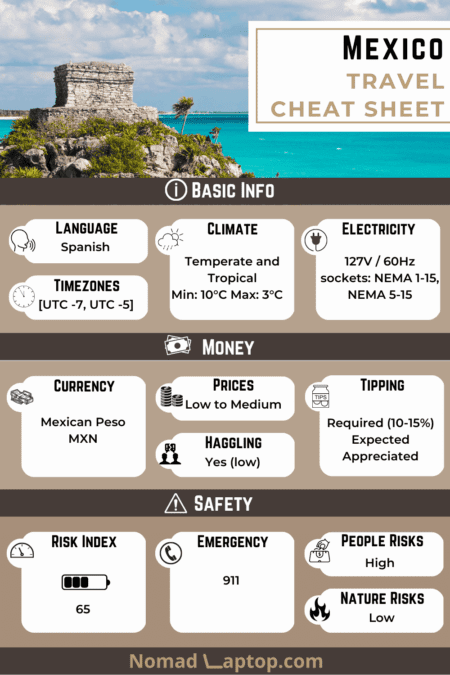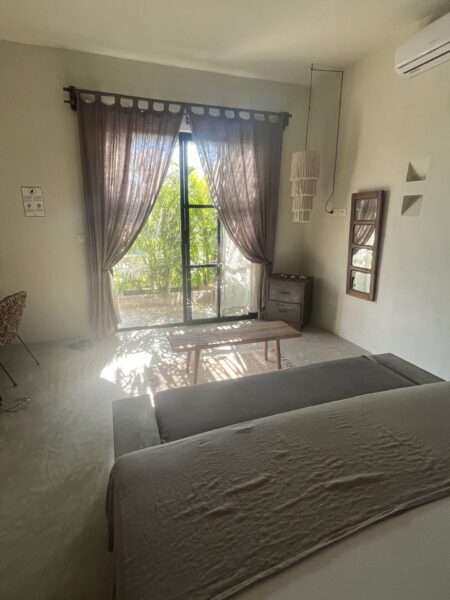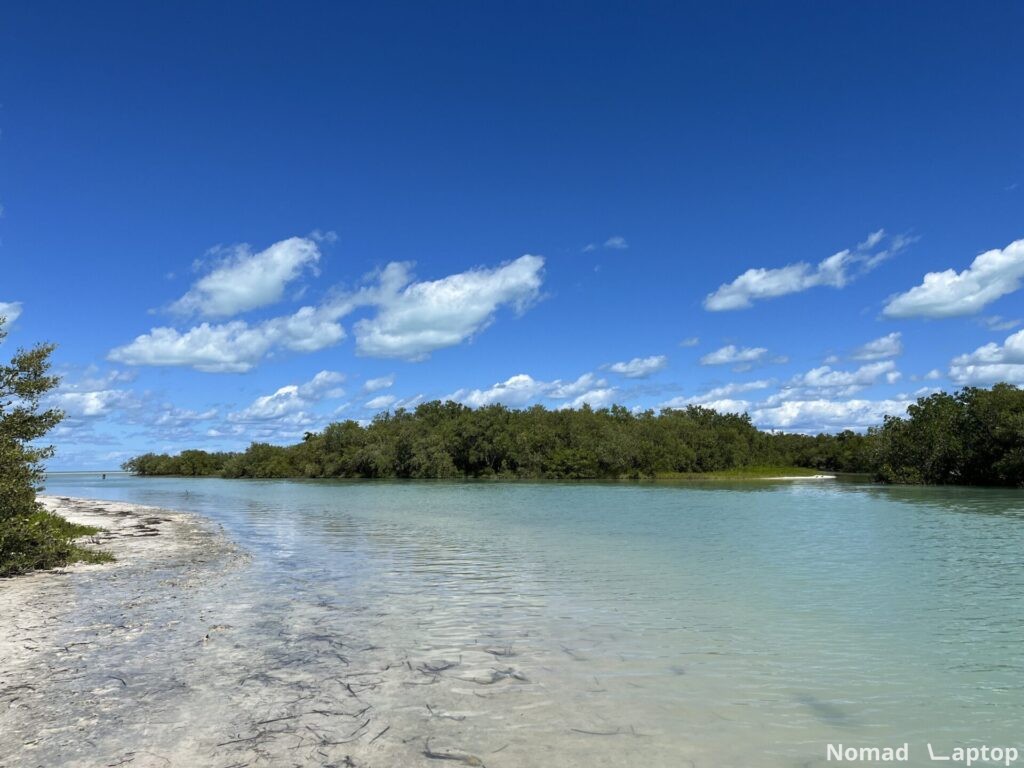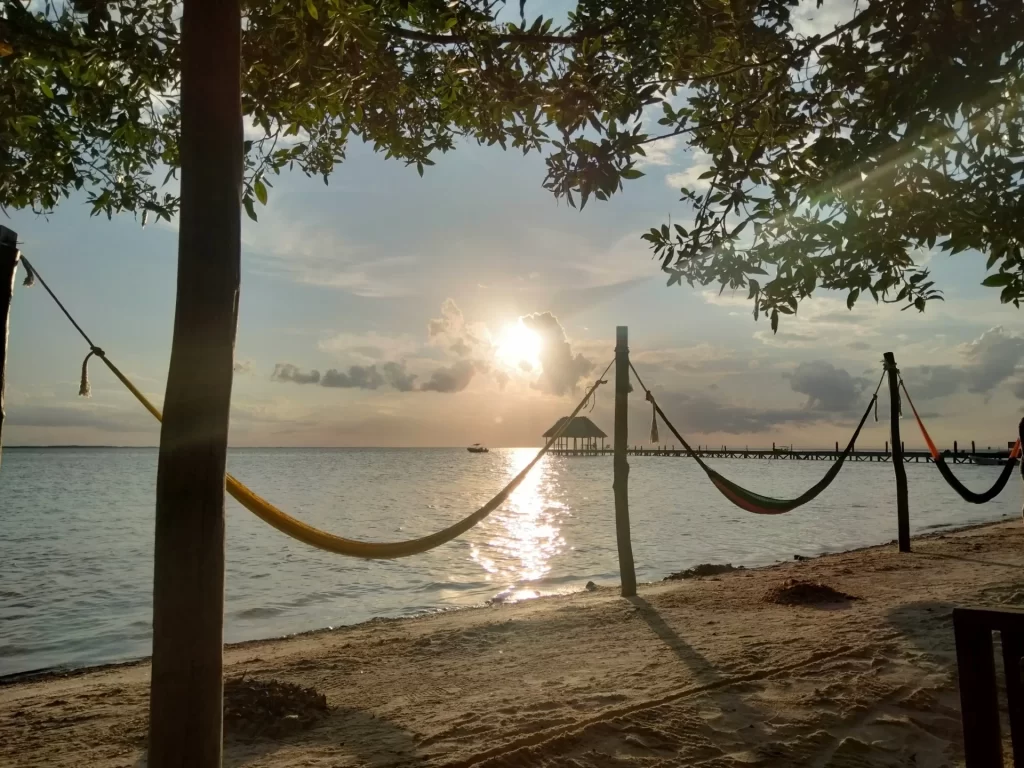Isla Holbox (meaning “black hole” in Yucatec Maya) is a small island in the Mexican Caribbean situated north of Cancún.
Having its origins as a fishing village, it used to be largely unknown to tourists. Nowadays, it has grown considerably, but the island still manages to maintain a kind of undeveloped feel and local charm thanks to its being off-the-beaten path and not yet completely converted to tourism. As such, it is a perfect destination for those looking for a tropical paradise but away from the crowds of Cancun or Tulum, or the more famous island destinations of Isla Mujeres and Cozumel.
The island is separated from the mainland by a 10-kilometer stretch of water in the lagoon. On its extremities, the western Punta Coco showcases bioluminescence, and the eastern Punta Mosquito in the natural reserve offers huge amounts of birds in the Yum Balam ecological reserve.
The beauty of Holbox is its simplicity, the natural environment and the slow rhythm it exists in. Its main attractiveness comes from its local charm and its incredible biodiversity, and it is one of the few locations on the Riviera Maya where sunsets can be seen, making it a wonderful place to relax while enjoying the sunsets on the iconic hammocks hanging on all beaches.

What to expect
- Incredible biodiversity, especially birds, and the large presence of whale sharks
- World-famous joyful and colorful scenes from Mexico
- Iconic hammocks on the sea shore.
- With unpaved roads and an island prone to flooding, be prepared to walk in knee-deep mud.
- Laid-back attitude of a fishing island not yet completely converted to tourism.
- Awe-inspiring sunsets.
- Great for kitesurfing.
Tips & Impressions
- Only one major: I went to Holbox in October after having fled from Belize because of a tropical storm that turned into a hurricane. I may have been particularly unlucky, but the island is known for its flooding during the wet season. All roads were completely submerged by half-meters of water. On the island, there are no cars but rather 4-wheel-drive carts, which allow you to move within the flooded streets. I used one only once, and the rest of the time I walked around or used the free beaten-up bikes offered by my hotels. I lost two pairs of flip-flops while on the island, sucked and devoured by the mud. After the initial sort of shocking arrival, I got used to it, and every transit across the island would mean reaching the hotel, beach, or whatever destination completely covered in mud from the falls, sprays of water, etc. It just gave me an even greater desire to refresh and clean up in the sea or pools.
Country Info
- Language: Spanish is the official language.
- Population: 131+ million (2019 est.)
- Ethnic Make-up: mestizo (Amerindian-Spanish) 60%, Amerindian or predominantly Amerindian 30%, white 9%, other 1%
- Religions: nominally Roman Catholic 89%, Protestant 6%, other 5%
- Political System: Federal republic
- Currency: Mexican Peso (abbreviated as $ which can be misleading at first)
- Credit Cards: Even in some highly touristic areas such as the Riviera Maya, cards are not always accepted.
- Electricity: Socket types A and B, 127 volt / 60 hertz
Check the Mexico page for more country general information

Safety
- Safety: Holbox is extremely safe. Because it is part of the Quintana Roo state and generally the Riviera Maya, which is highly geared towards tourism, and because of the size of the island itself, it is less prone to criminality with respect to other parts of Mexico. Pickpocketing, mugging, and drug-related crimes are the lowest in the country.
- Emergencies number: 911
- Natural risks: The larger risk, which is itself very small, comes from potential tropical storms and hurricanes. Tropical storms often hit the region of Central America. However, Mexico is usually skipped since the storms and hurricanes hit and move north, losing intensity as they travel over land, leaving Mexico one of the last to be hit, usually with a lower intensity. That being said, the island faces the Atlantic Ocean, below the Gulf of Mexico, and can be hit harder than other areas on the coast.
Getting there
- Holbox can be easily reached by ferry from the nearby port of Chiquilá with a 15 minutes traversal. As in many towns, there are plenty of private car parks near the port where cars can left and looked after.
- There are no cars on the island and all roads are unpaved, so moving around is done either by foot, bicycle or through the 4×4 golf cart taxis which can also be rented.
Weather
Holbox has a tropical savannah climate. This means that with high humidity it has very warm temperatures between 27° and 32°C all year round during the day and rarely cools down below 20 degrees at night.
The difference between dry and wet season can be striking. In the dry season, the humidity is lower and temperature more pleasant, with the consequence that it is high season and prices soar. The wet season is characterized by frequent, short-lived but intense rain showers. Since the island is completely flat, has no drainage system, and is entirely made of sand, all the street go under water. This is a characteristic in itself but definitely makes the stay less enjoyable.
Etiquette
- Service, despite being excellent, is relatively slow. However the whole region is a vacation destination and the appropriate, laid back attitude should be embraced without going into entitled rants if something is not absolutely perfect.
- Tipping: The Propina is expected in many places which have a touristic vocation and should be around 15%. US level of tipping such as 18 or 20% is uncommon, but clearly highly appreciated.
- Society and business is highly hierarchical therefore authority must be respected at all times.
- For female travellers, Mexico has a long standing culture of Machismo. As such it may be commonplace to receive remarks and these signs of stereotypical males should not be interpreted as harassment
Flora & Fauna
- Thanks to being part of the large ecological reserve of Yum Balam there is a wide variety of wildlife on the island, most notably birds, among which seagulls, flamingos, pelicans, herons and many seagulls which fly stationary on the beach coast and are often fed by tourists.
- The island is also famous for its large number of whale sharks as well as having some bays which showcase bioluminescent plankton.
- The marsh areas with several streams host a large number of crocodiles.
- On top of this, there is the usual range of reptiles, most notably lizards, which bask under the sun together with their bird companions.
Deals for Isla Holbox
Stay Overview
I split my stay in two parts. First, on the most eastern possible area, before the ecological reserve, at Blue Holbox, a wonderful boutique hotel with luxury cabins facing the sea, separated from the beach by only the narrow sandy road coasting it. The cabins rooms are very spacious, with high quality furniture and interiors and a wonderful balcony or patio which allows to relax without going to the actual beach.
I then moved west, towards Punta Coco, which is the less developed side of the island, and stayed at Hotel El Nido, a small boutique ecological hotel. The hotel is near Punta Coco and as such separated from much of the rest of the island. The hotel offers bicycles to move around, which were absolutely fundamental to traverse the completely flooded sandy roads when I visited. Despite being an eco hotel the rooms offer all the amenities needed. Together with the extremely friendly owners, their small kitchen cooking home made food and the large pool, created a wonderful stay for the couple of days I stayed there.

Playa Holbox
Playa Holbox

About
The beach of Holbox is the main stretch of beach of the island, located north facing the ocean and stretching from the eastern Punta Coco to the west up until the large ecological reserve of Yum Balam.
Many deck chairs and cabins dot the beach which has beautiful sand and a calm sea, with frequent seagulls roaming around. Given the lagoon nature, the water is shallow and calm and it can be quite a walk to reach the depths further out.
Impressions
I went to Holbox right after a hurricane had struck Central America and its consequence of tropical storm loomed for a couple of days on the Riviera Maya. The island is known to be prone to flooding but I didn’t expect it that much. I brought with me only a backpack from Chiquila and was supposed to walk for 10 minutes to my cabaña but it took me half an hour in knee deep water, losing every 10 steps my flip flops in the sucking mud and scrambling around the murky waters of the streets trying to recover them.
For the first few days, because of the weather, I was not able to enjoy that much the beach, which had also a high amount of seaweed, but spending time drinking Coronas and margaritas and eating guacamole in warm weather was wonderful anyways.
Punta Mosquito & Yum Balam ecological reserve
Punta Mosquito

About
The aptly named Punta Mosquito which depending on the season is swarming with mosquitoes is part of the larger Yum Balam reserve, which encompasses other islands such as Isla Mujeres near Cancun.
The last hotel is hotel Las Nubes, and from there there are 38 kilometers of sand plateaus which host the endemic birds of the island, among which flamingos. The water is shallow as in all areas of the island, the water is crystalline and the beaches are virgin with hundreds of shells on the shore.
Impressions
There are two routes to reach the sandy islets area of Punta Mosquito: either through the sand bags in the water some hundred meters out, or coasting the beach through the natural reserve and passing by rivers which lead into the laguna. Since I went rather early in the morning the tide was high and I did not want to be bogged down walking another day within the mud so I went with the second approach. However after a couple of river crossings I reached a major and deeper river with water eerily still and without any birds or markers to gauge it’s depth. With another danger sign of crocodiles which this time I took seriously, I opted to take a long walk in the shallow waters towards the sand bags out at sea.
Playa Punta Cocos
Playa Punta Cocos

About
Punta Coco is a more quiet beach but quite famous on the island as it is near to some of the bays were people go see bioluminescence, as well as hosting the renowned swings on the water, and most importantly it faces directly the sunset which is a major attraction of the island together. The water is shallow as in all the island, and the iconic hammocks are the predominant sight (after the insects of course).
Impressions
Here the mosquitoes reign supreme and unchallenged. The hotel doesn’t have a cat (like almost all the previous ones in Mexico where I stayed at) but a super fat asthmatic french bulldog which desperately and unsuccessfully tries to catch the geckos at night. In the evenings I would take the beaten up bike of the hotel and cycle around either to Punta Coco beach to see the sunset or to town to eat something.
This side of the island is very undeveloped from a tourism point of view and despite the absence of any street lights and most importantly getting bogged down in the meter deep “puddles” at night, it was nice to ride around in complete darkness and silence under the stars.
Closing thoughts
Despite not being considered anymore a “hidden gem” and quickly converting to tourism, Holbox manages to maintain its natural and genuine local feel.
When I visited I was running away north from a tropical storm and arriving at a beach destination was wonderful despite the suboptimal weather conditions.
The “highlight” of the stay for me was the flooding of the island in the sense that it was an experience in itself and it also gave an even more genuine and rugged aspect to the stay. The bad weather made the few days of clear skies and red sunsets even more memorable and enjoyable.
I believe the island is quickly becoming like other similar Caribbean destinations and it should be visited as soon as possible before the inevitable full conversion occurs. The fishing village origins and local charm of the island can still be felt and the lack of large resorts and slew of visitors like in other nearby beach destinations, makes Holbox a wonderful, relaxing place where one can enjoy the calm waters of the lagoon, the incredible biodiversity of the natural reserve, the sunsets, and the bioluminescence at night, all immersed within the easy going, joyful and characteristic Mexican vibes.




